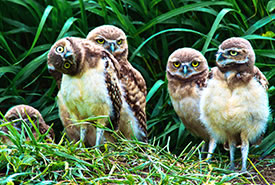
Burrowing owls (Photo by Don Dabbs)
Burrowing owl
This owl receives its name from its habit of nesting in underground burrows. Most other owls live alone in trees while burrowing owls are known for living in groups on the Prairies. Unlike other owls that hunt at night, burrowing owls hunt for prey both day and night.
What does the burrowing owl look like?
Burrowing owls are speckled brown and white, with round yellow eyes and a yellow beak. Males are slightly lighter in colour than females. They can be easily recognized by their long legs, short tail and small size. They can be found standing on fence posts or on the ground foraging for mice, grasshoppers and other insects, but are otherwise fairly inconspicuous.
Where does the burrowing owl live?
Burrowing owls are found on plains of open short grass prairie in Alberta and Saskatchewan. A few small populations of reintroduced individuals exist in Manitoba and BC. Burrowing owls require short vegetation and permanent cover around burrows, but rely on thicker stands of grasses for foraging. These birds forage for insects, rodents, birds and lizards. Because of the owl's need for different types of cover, pastureland grazed in varying intensities is needed for this species' survival. Burrowing owls rarely dig their own nests, preferring instead to use the abandoned burrows of mammals, such as prairie dogs, Richardson’s ground squirrel and badgers.
What is the burrowing owl's conservation status?
Conversion of prairie for development and agriculture negatively impacts burrowing owl breeding habitat and populations. Because of the importance of prairie dogs and badgers to burrowing owl nest creation, the owls are impacted by any loss of habitat to these species as well. Pesticide application to deter ground squirrels, and insecticides consumed with insects, are also a large risk for burrowing owls.
The Canadian population is estimated at as few as 270 individuals as of 2015 and is assessed as endangered by the Committee on the Status of Endangered Wildlife in Canada. The population declined by 90 per cent in the 1990s, and declines have continued over the past two decades. The Canadian Wildlife Service predicts that, unless its declining population trends are reversed, the burrowing owl will be extirpated (locally extinct) within a few decades. The population in the United States is considered to be stable at the core of the species range but has declined in several states.
What is NCC doing to protect the burrowing owl's habitat?
NCC's work in conserving key nesting habitat in the Missouri Coteau and in Alberta's Sage Creek Uplands is ensuring that this owl has a fighting chance at survival.
In the summer of 2011, burrowing owls were also confirmed to have returned to NCC's Old Man on His Back Prairie and Heritage Conservation Area, signalling the health of this ecosystem.
NCC supports the efforts of the Burrowing Owl Conservation Society of BC to reintroduce this species in BC’s southern interior. NCC hosts several reintroduction sites on our conservation lands in this area.




